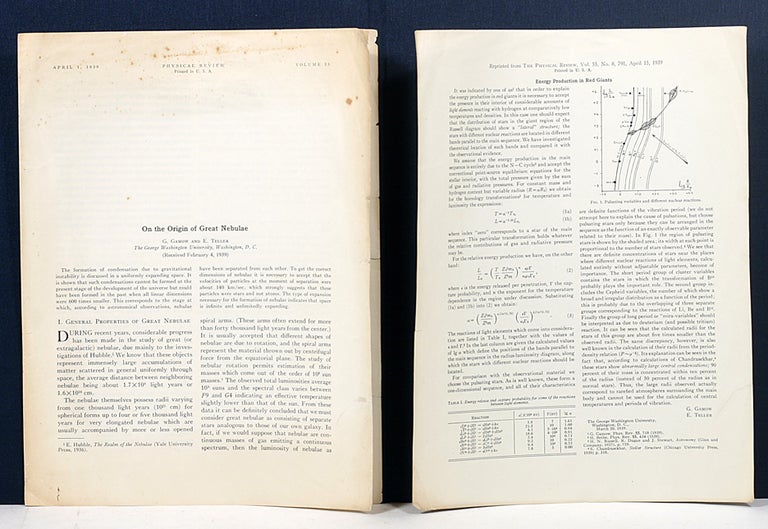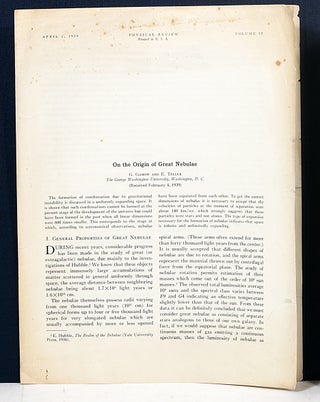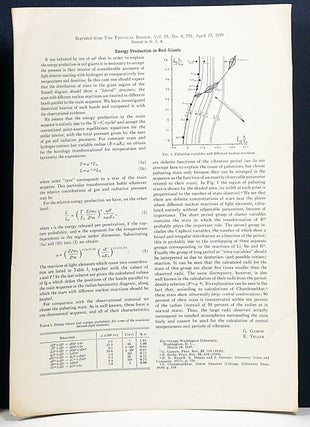On the Origin of Great Nebulae. WITH: Energy Production in Red Giants
”Thus in order to understand the formation of great nebulae and to satisfy the condition of continuity at the moment of their separation, it is necessary to accept the hypothesis that space is infinite and ever expanding...”
RARE FIRST EDITION OFFPRINTS of Gamow and Teller’s early papers on cosmology, including “a kind of blueprint” for Gamow’s later theory of the Big Bang.
In “On the Origin of Great Nebulae,” "written jointly with Edward Teller, his friend and colleague at George Washington University, Gamow dealt for the first time explicitly with the Friedmann-Lemaitre equations. The two authors concluded that, 'our theory of nebular formation requires that the velocity of expansion remains nearly constant while the distances between nebulae increase by a factor of 600.' In the last section, they considered the cosmological consequences which they discussed from the form of the fundamental (Friedmann-Lemaitre) equation for the expanding universe as given by Richard Tolman in his important textbook of 1934… [and concluded]: 'Thus in order to understand the formation of great nebulae and to satisfy the condition of continuity at the moment of their separation, it is necessary to accept the hypothesis that space is infinite and ever expanding.' As they noted, this went against the conclusion that Edwin Hubble and Tolman had reached in 1935, namely that the universe must be closed and uncomfortably small. However, Gamow and Teller argued that the discrepancy might be resolved if it was admitted that the absolute luminosities of very distant (hence young) galaxies were higher than those nearer by. This idea was to play an important role in cosmology in the 1950s, but in 1939 it was merely a suggestion that lacked independent support.
"Gamow's work with Teller of 1939 was based on the expanding universe but did not presuppose any explosive event in the past, what ten years later would be coined the big bang. All they had to say about the state of the universe before the separation of the nebulae about 1.8 billion years ago was, 'Before that time, space must have been uniformly populated by stars, or by gas molecules, if we suppose that the formation of stars took place after the separation of nebulae.' Although still in the pre-big-bang tradition, the paper was in several respects to serve as a kind of blueprint for Gamow's later contributions to cosmology" (Kox and Eisenstaedt, The Universe of General Relativity).
In “Energy Production in Red Giants,” published two weeks after “On the Origin of Great Nebulae,” Gamow and Teller “carried out one of the earliest studies of the temperature dependence of thermonuclear reaction rates and applied their ideas to an investigation of energy production in red giant stars” (Libby and Bibber, Edward Teller Centennial Symposium).
On the Origin of Great Nebulae. Offprint from: Physical Review, Vol. 55, April 1, 1939, pp. 654-657. Four pages, as issued without wrappers. Light edgewear, a little foxing. Energy Production in Red Giants. Offprint from: Physical Review, Vol 55, April 15, 1939. One page, as issued without wrappers. Small closed tear to margin, otherwise fine. Lancaster and New York: American Institute of Physics, 1939. Housed together in custom cloth case. RARE.
Price: $1,550 .




